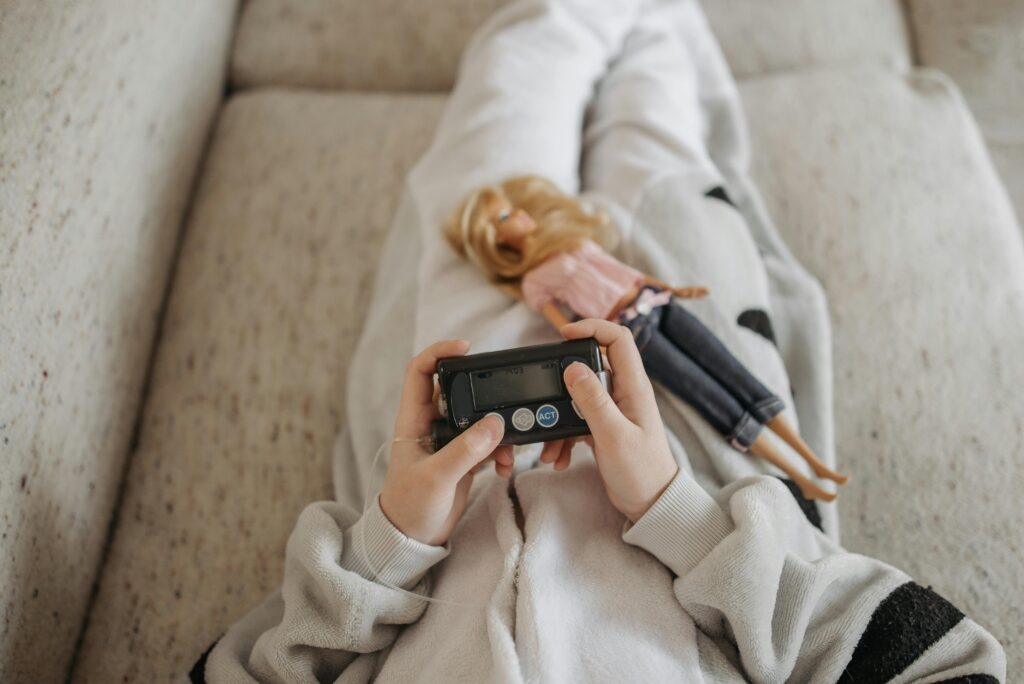Helping your child gain independence in managing diabetes is a lifelong gift that brings confidence, resilience, and better health. Below, you’ll find proven and nurturing steps that support your child’s journey toward self-reliance.
These tips are powered by emotional insights and clear guidance—perfect for parents and caregivers aiming to raise empowered kids.
🧩Understanding Diabetes Independence
Independence means your child can perform essential diabetes tasks—like checking blood sugar or giving insulin—with care and accuracy. But it’s not just about tasks; it’s about building a mindset of confidence, responsibility, and teamwork.

Key Sub-Terms to Know:
- Blood Sugar Checking: Pricking a fingertip or using a CGM (continuous glucose monitor) to measure glucose.
- Bolus Insulin: Insulin taken to manage meals or correct high blood sugar.
- Carb Counting: Calculating carbohydrate intake to adjust insulin amounts.
- Hypoglycemia Management: Handling low blood sugar episodes safely.
- Diabetes Distress: Emotional strain from managing the condition over time.
In any case, your pediatric endocrinologist is always there to offer guidance, as a parent or caregiver, in your journey to empower your child in managing their medical condition.
1. Start With Small and Simple Tasks 🩺
Introduce independence in steps:
- Encourage your child to read blood sugar numbers aloud.
- Let them press buttons on their insulin pumps or their meters.
- Teach them to pick snacks that fit their carb counts.
Even small tasks build big confidence!
How to Teach Blood Sugar Reading
- Use morning checks as a learning chance: “Can you tell me your number?”
- Praise successful reads to build trust and excitement.
2. Create a Learning Timeline
Every child is different. Consider this flexible guide:
| Age Range | Tasks to Learn |
| 6–8 years | Snack choice, blood check, pump buttons |
| 9–11 years | Carb counting, insulin with oversight |
| 12–14 years | Independent bolus, tech troubleshooting |
| 15+ years | Decision-making, clinic coordination |
This helps parents track progress without rushing their child.
How to Adapt Based on Learning Style
- Auditory learners: Explain tasks out loud.
- Visual learners: Show step-by-step guides or use apps.
- Hands-on learners: Let them do the steps physically with guidance.
3. Use Visual Aids and Tools
Children love visuals. Use:
- Color-coded charts to track daily blood sugars.
- Stickers or star charts for achievements, like “First bolus done!”
- Interactive smartphone apps to gamify their care.
Visuals make abstract stuff real and fun!
How Stickers Make a Big Impact
- Stickers celebrate effort and skill—“You used the pump all evening!”
- They build motivation and teamwork between parent and child.
4. Set Clear and Positive Rules
Guidelines help kids know what’s expected:
- Blood checks every 4 hours and at meals.
- Bolus within 15 minutes before eating.
- If blood sugar is <70 mg/dL, follow the “15–15 rule” (eat 15g carbs, check again in 15 minutes).
Explain why—it helps them do tasks with purpose.
5. Practice Real-Life Scenarios
Prepare them for everyday situations:
- Leaving for school.
- Attending sleepovers or camps.
- Playing sports or games.
Role-playing builds readiness and lowers anxiety.
How to Role-Play
- Act out waking up and checking blood sugar.
- Pretend they get low at a friend’s house—let them do carb treatment.
- Take turns playing “parent,” so they learn how to advocate.
6. Share Responsibility Over Time
Move from “I do it” to “You do it, I help” to “You do it”.
Gradual release means they feel more confident and capable.
7. Build Emotional Support
Emotions matter. Support your child through:
- Praising effort, like “You remembered all your steps today!”
- Normalizing feelings, such as “I’m proud, and it’s OK to be nervous—many kids feel the same.”
- Peer support, like connecting with other diabetic kids.
8. Use Kid-Friendly Tech
Technology helps independence.
- CGMs show real-time blood sugar graphs.
- Insulin pumps make dosing easier.
- Apps that let the child log sugars and carbs.
Tech is helpful, but don’t replace teaching the basics manually.
Tech Teaching Tips
- Pair lessons with tools: “Let’s test using the pump—then we’ll do it twice together.”
- Explain how tech gives them control.
9. Collaborate With School and Caregivers
Ensure independence in different places:
- Create a Diabetes Care Plan with school staff.
- Train teachers and school nurses.
- Plan for trips and sports, complete with emergency kits and contact info.
This makes sure their independence is supported wherever they go.
10. Celebrate Growth and Review Progress
Every month:
- Track how many tasks your child did solo.
- Review blood sugar logs and read any CGM trends.
- Celebrate wins with a fun treat or special time together.
This positive check-in feels like a team effort and fosters pride.
Why This Approach Works
- Builds confidence: Successful small steps create big achievements.
- Reduces stress: Predictable tasks and routines calm anxiety.
- Strengthens emotional resilience: Supportive praise and open talk help them bounce back.
- Improves medical adherence: Consistency leads to better blood sugar control.
- Grows life skills: Care, responsibility, and self-awareness transfer beyond diabetes.
Common Challenges and Solutions
“I forgot!”
Use prompts:
- Set phone alarms.
- Associate tasks with routine events—”Check, then you brush your teeth.”
“It’s annoying.”
Validate feelings: “Yes, it can be annoying sometimes. Let’s pick tomorrow’s snack together!”
Fear of mistakes
Normalize errors: “Mistakes are learning moments. Every person with diabetes makes them.”
Role-play quick correction steps to build confidence.
How Parents Can Stay Peaceful and Supportive
- Model calm behavior—kids pick up on stress.
- Plan, especially before busy times or travel.
- Take breaks and care for yourself. A rested parent is a supportive parent.
Help Your Diabetic Child Be Independent in Their Medical Condition ✨

Helping your child grow independent in managing diabetes is about:
- Teaching gradual skills.
- Offering visual and emotional support.
- Encouraging step-by-step growth.
- Recognizing and celebrating achievements.
With love, patience, and teamwork, your child will thrive—and so will your family. Diabetes care isn’t just medical—it’s about building character, confidence, and independence. And that’s a success worth celebrating every day!
Checklist: 10 Steps to Independence
- Start Small (read sugars, press buttons)
- Learning Timeline (age-based goals)
- Use Visual Aids (charts, apps, stickers)
- Clear Rules (check/treat schedules)
- Practice Scenarios (school, sleepovers)
- Share Responsibility (step-by-step release)
- Build Emotional Support (praise, normalize feelings)
- Use Tech Wisely (CGMs, pumps, apps)
- Coordinate With Others (school, caregivers)
- Celebrate and Review (progress checks monthly)
Your guidance plants seeds of lifelong self-care. Every success—big or small—matters greatly.
Related Resources for Families
Explore Omega Pediatrics’ helpful content for parenting and diabetes:
- Kid’s Lunchbox 101: How to Pack Nutritious School Lunches—lunch ideas that support blood sugar control.
- Building Strong Parent-Child Relationships: 15 Proven Strategies for Success—great for talking about diabetes worries.



